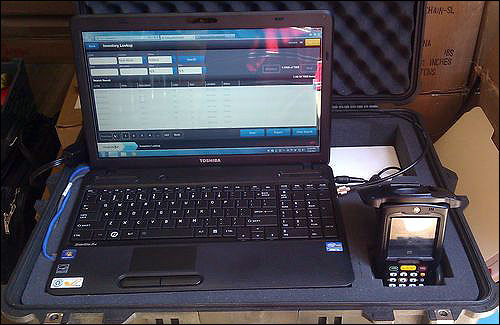While many retailers are receiving merchandise with RFID tags attached by their suppliers, others are still daunted by the prospect of employing radio frequency identification for inventory-tracking purposes. Many RFID deployments include the installation of one or more fixed readers, as well as software and integration services. Truecount aims to meet retailers’ needs with what it calls “RFID in a briefcase”—a solution, known as RFID 2-GO, that provides all of the necessary RFID hardware and software (except for tags), packed into a compact carrying case. The company began marketing the system this summer.
The heavy-duty protective case contains a laptop computer, a Motorola Solutions FX7400 fixed reader with an AN710 antenna, and a Motorola MC3190-Z handheld interrogator and cradle for uploading data from the handheld to the laptop. To operate the system, a user need only plug the computer into a power supply, and the reader into the laptop’s USB port. The RFID 2-GO system’s origin is a mobile solution known as TC Mobile Merch, developed for the WaterWheel Foundation, the charitable arm of the rock band Phish (see Phish Foundation Saves Labor at Concerts). But the RFID 2-GO version, says Zander Livingston, Truecount’s CEO and cofounder, is intended for a different audience: small to midsize retailers, rather than mobile merchants.

The fixed reader can be used to commission new tags—to create a link between the tags’ unique ID numbers and the products on which they are attached—as well as to receive goods with RFID tags already attached, or to process transactions at the point of sale. The handheld, alternatively, is intended for such uses as cycle counting and item searches performed on the sales floor, or in the stock room.
The laptop is loaded with Truecount’s RFID 2-GO software, for storing data regarding inventory on hand, performing inventory checks, indicating when items are sold, and viewing alerts when inventory levels have reached a threshold at which products need to be replenished.
For example, Livingston says, a store’s staff may wish to inventory a particular category of items, such as scarves. In such a scenario, the workers can use the handheld to read the tags of all scarves located on the sales floor. The RFID 2-GO software will then indicate which items are missing, at which point the user could utilize the system’s Geiger counter function to search for the errant merchandise on the sales floor, or in the stock room. If the reader was used at the point of sale, the system could also determine when a particular quantity of scarves had been sold, and display an alert should additional stock need to be ordered.
“This is a complete solution,” Livingston states, noting that it can manage hundreds of thousands of tags. The RFID 2-GO system, already being utilized by a handful of retailers, costs approximately $11,000, though Truecount offers the option of paying $375 per month for four years. According to Livingston, end users can deploy the system within their stores for a period of three months without a purchasing commitment, paying only what the company describes as a small fee to cover the cost of any tags (if requested), as well as shipping and staff orientation. Truecount provides training for store management and employees. The instructional process typically lasts one day, he says, but can include two days, if necessary.

